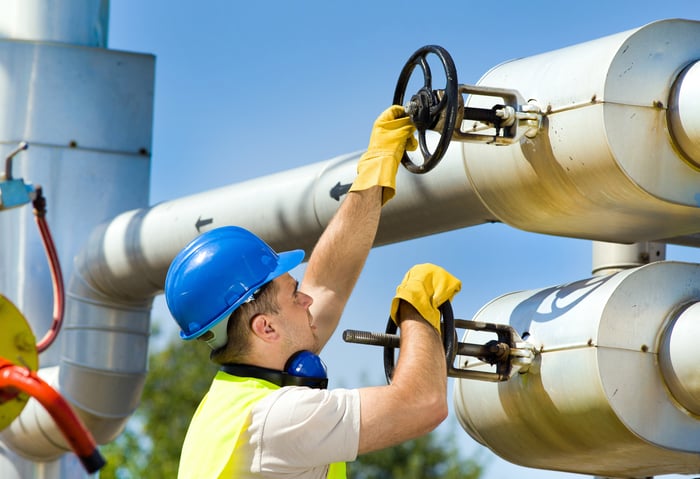Kinder Morgan, Inc. (KMI 3.46%) and Enterprise Products Partners L.P. (EPD 1.41%) are two of the largest midstream oil and gas players in the United States. Kinder cut its dividend in 2016, but is set to start hiking it again in 2018.
Is now the time to pick up this recovering giant? Or would you be better off with Enterprise, which has a higher yield today but has announced plans to slow its distribution growth? Here are some key facts to consider beyond the dividend.
What happened to Kinder
Kinder Morgan was expanding aggressively when the oil market started to turn south in mid-2014. Although its business was heavily fee-based, the decline in oil prices made it hard for the company to raise capital for growth. Management made the tough call to cut the dividend in order to free up cash to continue its expansion plans.

Image source: Getty Images.
It was the right decision for the business, which has been proven out by the current plan to materially increase the dividend between 2018 and 2020. The dividend is expected to grow at an annualized rate of 25% over that span. It will increase from a current annual rate of $0.50 a share to $1.25. Using today's share price, that $1.25 dividend figure will equate to a yield of around 7.4%. The current yield is just 3%.
There's only one problem here: leverage. Kinder's debt-to-EBITDA ratio rocketed to 9.5 in 2016, which is part of the reason it chose to cut the dividend. It's down to around 6.5 today, but that's still relatively high compared to peers like Enterprise, where debt to EBITDA is a far more modest 4.5 times. Kinder has always operated with more leverage, so this disparity isn't unusual. However, the 2016 dividend cut shows what that leverage can do if things don't go as planned. Kinder's goal is to continue to reduce leverage, which is admirable, but I'd still err on the side of caution here.
Slowing down
That's where Enterprise Products Partners comes in. The units currently yield 7%, so there's no need to wait for three years of distribution hikes to get a decent yield. And as noted above, Enterprise's business uses far less leverage. That's one factor that allowed it to continue to hike its distribution right through the downturn, pulling its annual streak of increases out to 20 years. The distribution, meanwhile, was backed up by slow and steady distributable cash flow growth between 2014 and 2016.
EPD Financial Debt to EBITDA (TTM) data by YCharts.
There's a fly in the ointment, however. Management has announced plans to slow distribution growth over the near term to a low single-digit rate. The ultimate goal is to self-fund as much of its $9 billion in capital spending as possible. On the surface, that sounds strangely familiar to what happened at Kinder.
But don't get too worried. The model for limited partnerships has historically been to push as much cash out to shareholders as possible while tapping the capital markets to fund growth. That meant selling debt and issuing new units, which dilutes current unitholders. Enterprise is attempting to change gears and stop issuing as many units -- it even hopes to start a buyback program at some point. In the end, that should make growth projects less expensive and lead to more cash available for shareholder distributions. I see this as Enterprise evolving as the midstream business matures.
Slow and steady
There's no doubt that owning Kinder will be exciting for dividend investors over the next few years. Who wouldn't want to see massive dividend hikes? But Enterprise's more conservative finances and move to self-fund its growth spending make it the better option in my opinion. It won't be exciting to own, but that's the point. You get a higher yield today, slow and steady distribution growth, and a shift in the business model that should be a net benefit over the long term as it adjusts with the sector in which it operates. A tortoise, to be sure, but the slowpoke often wins the long race.






